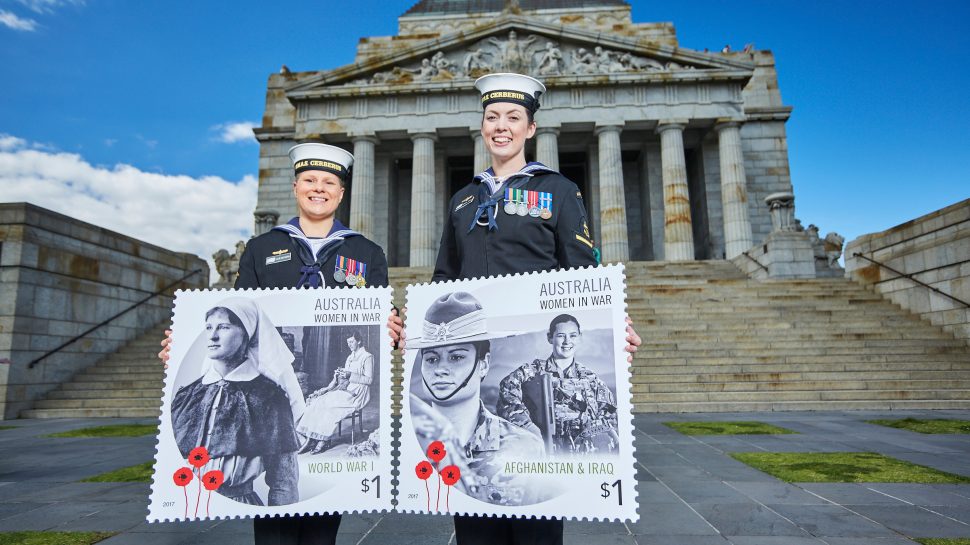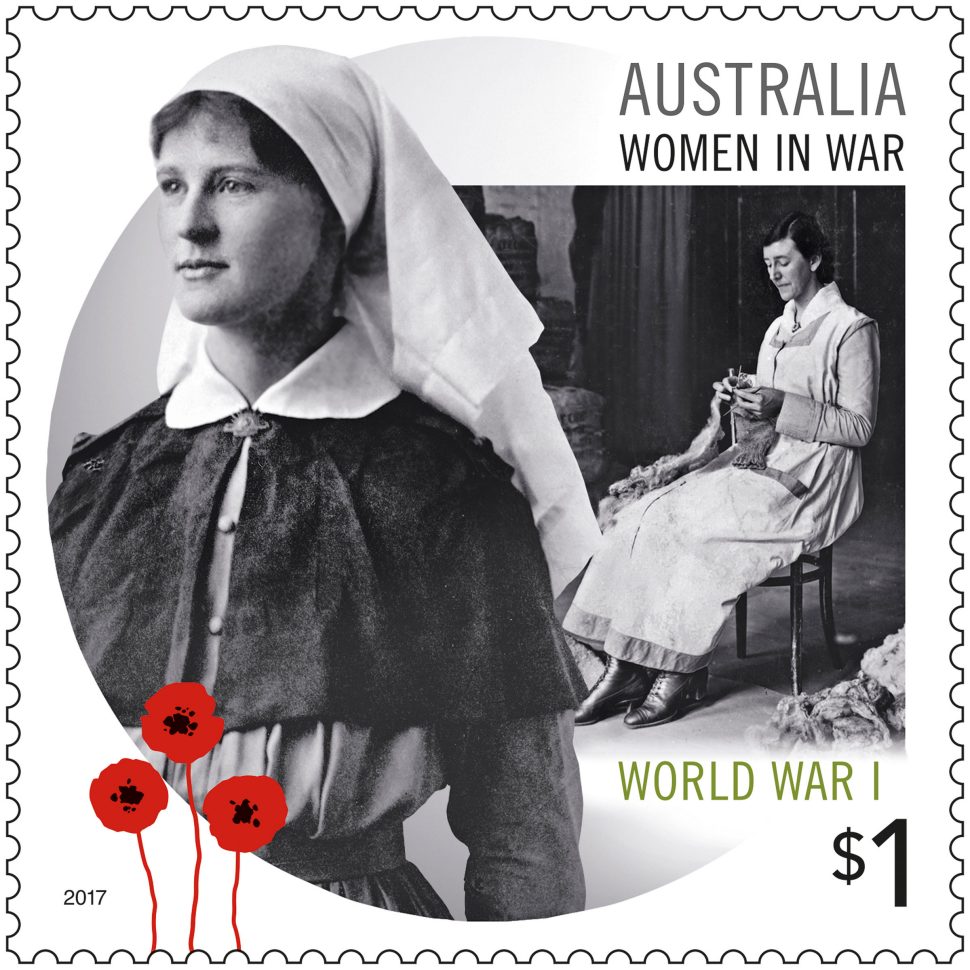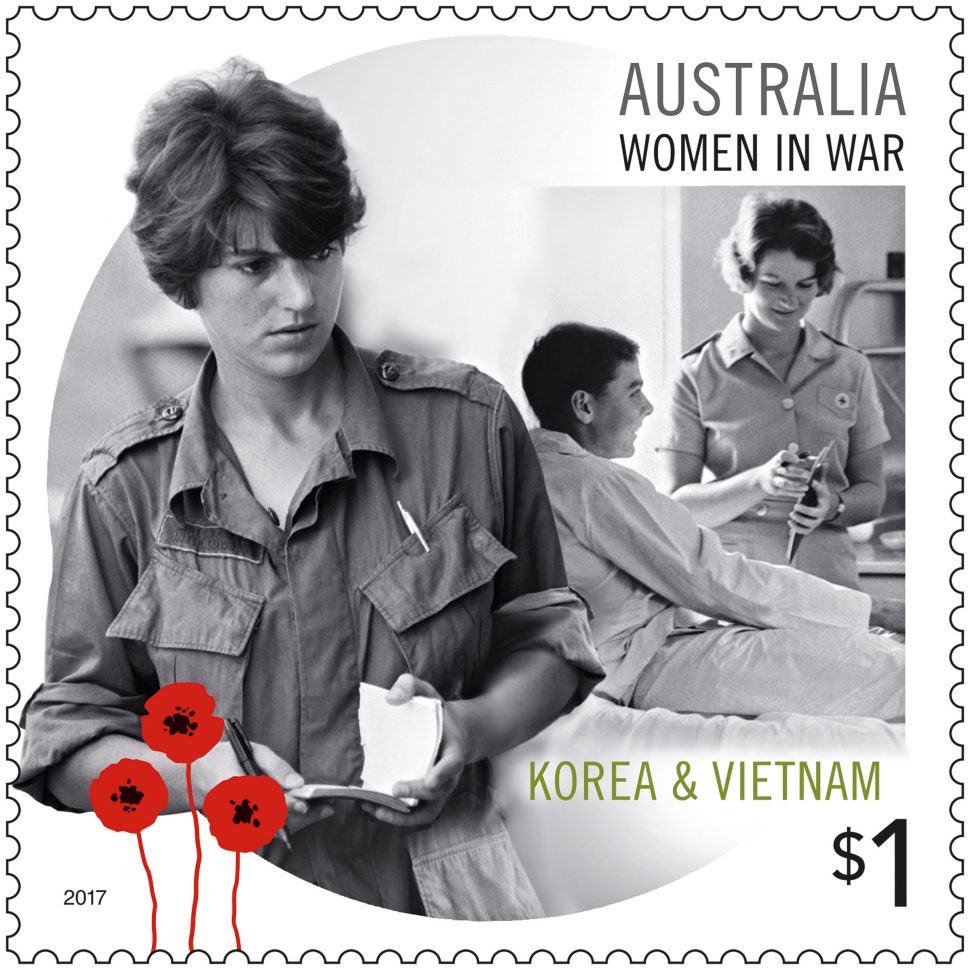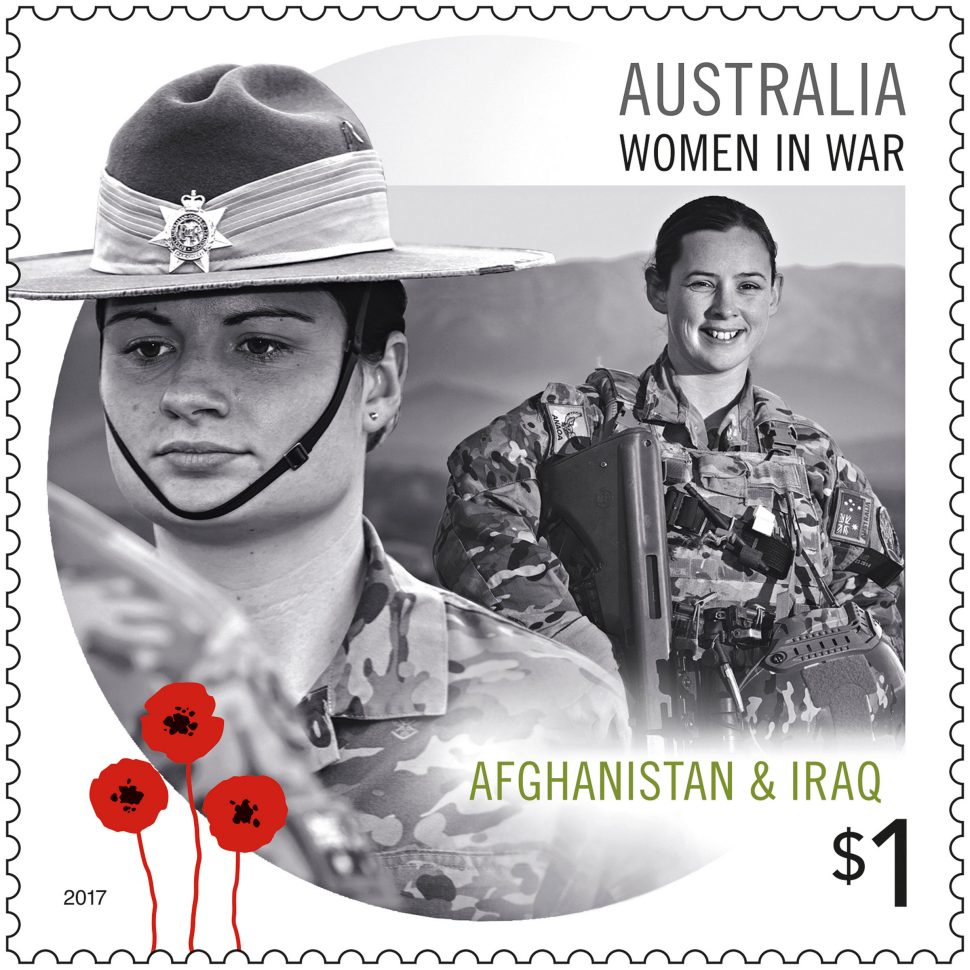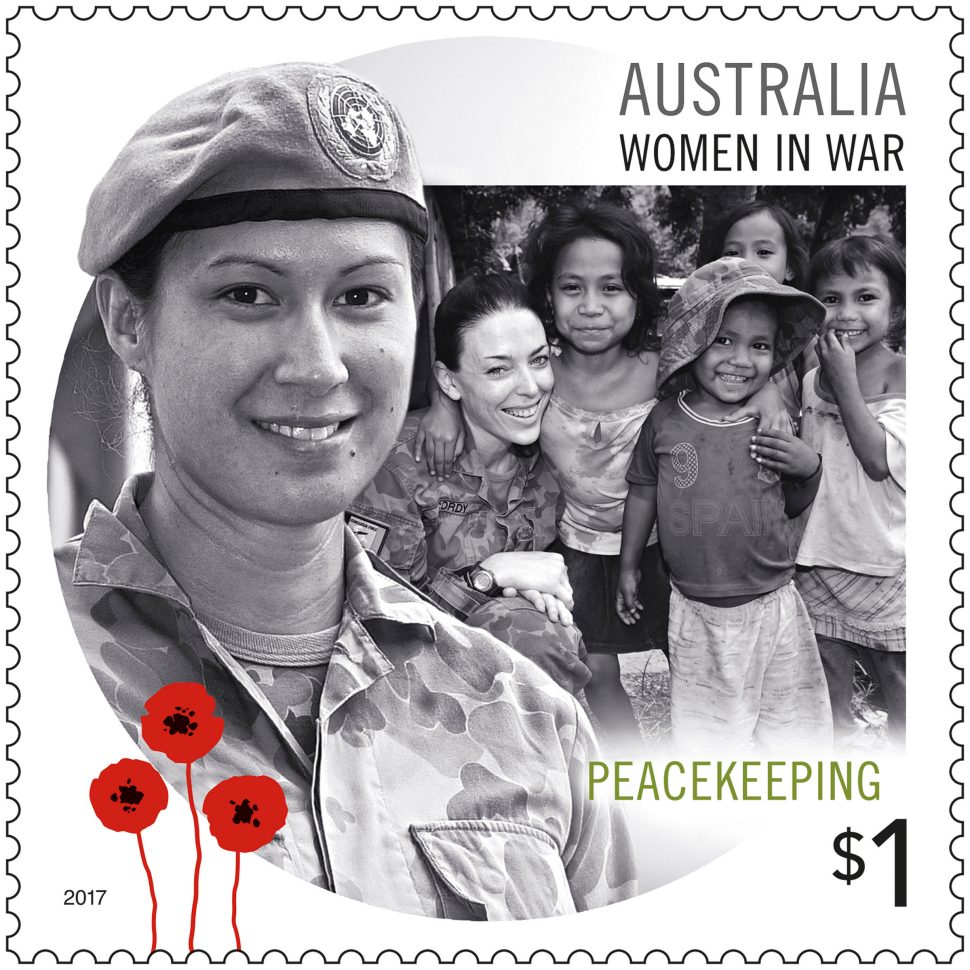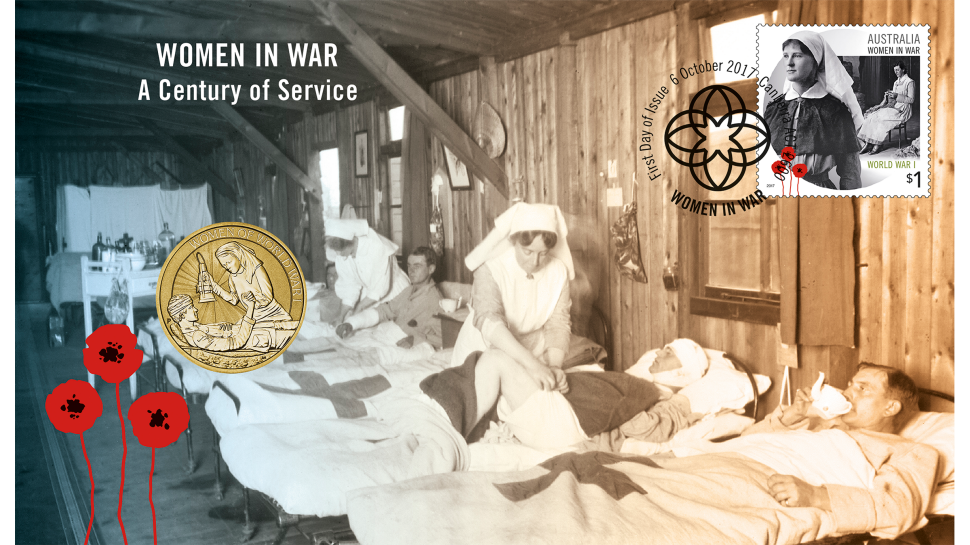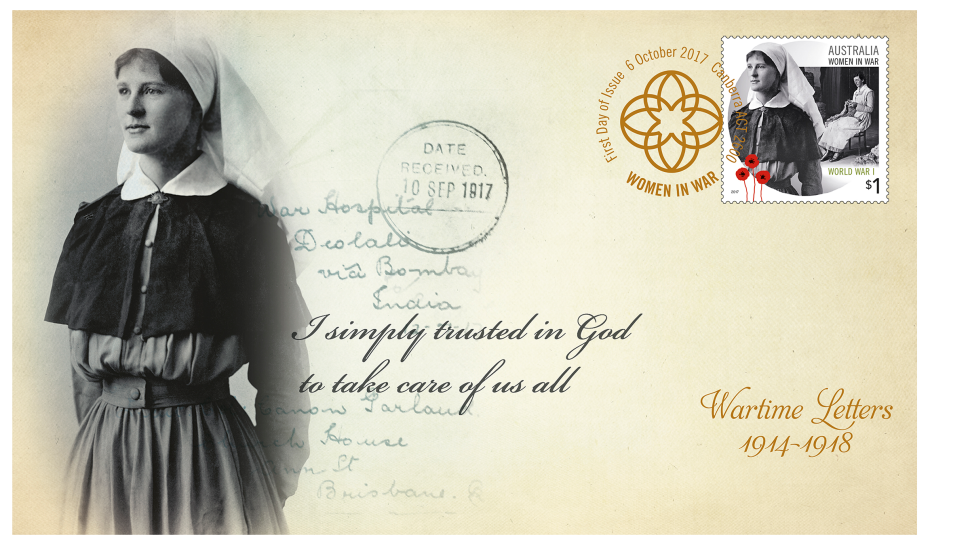Prior to and including World War I, the involvement of women in conflict zones was almost entirely limited to nursing. Even prior to 2013, women in the Australian Defence Force (ADF) were restricted from certain roles, such as mine warfare and clearance diving. Today, however, women can participate in all ADF employment categories. In 2015, 15.4 per cent or the ADF permanent workforce were women, as were 14.9 per cent of the total deployed force serving on overseas operations.
This stamp issue, which will be released on 6 October 2017, is the fourth in a series commemorating a century of service since World War I and acknowledges the evolving role of women in war and conflict. Designed by Stacey Zass, the stamps depict the contribution of women in each of the major conflicts since World War I in which Australia has had military involvement, as well as recent peacekeeping efforts.
World War I
During the Great War (1914–18), more than 3,000 nurses joined the war effort; 2,546 served abroad with the Australian Army Nursing Service (AANS), while others served with organisations such as the Red Cross. They ministered to the sick, wounded and dying, toiling in hospitals, casualty clearing stations and on hospital transports. Many nurses were decorated for their bravery, and by war’s end 25 had given their lives. It must not be forgotten that women on the home front also made an immense contribution. For the bitter European winter of 1916–17, Australian women knitted more than one million pairs of socks and made 65,000 sheepskin jackets for the troops.
The stamp depicts Ella Clow McLean, a Queensland nurse who joined the AANS in 1915 and served in India and Egypt. In the background is a Miss Coll, in Melbourne, knitting socks for the troops directly from the fleece.
World War II
It was not until World War II (1939–45) that war services other than nursing were opened up for women, although many women served in the nursing corps of the RAN, Army and RAAF. During World War II, 3,477 AANS nurses served, and 71 never returned, losing their lives during active service overseas. However, more women joined the auxiliary services that were established during the war to release men for combat roles. There were also many volunteer organisations and a Women’s Land Army to support agricultural production. Over 66,000 women enlisted in a branch of the women’s services during the war.
The stamp shows a member of the WAAAF (The Women’s Auxiliary Australian Air Force) defusing a practice bomb in Mildura, Victoria in 1944 and, in the background, a farmworker in the Women’s Land Army on the Victorian Government Experimental Farm, also in 1944.
Korea and Vietnam
During the Korean War (1950–53) Australian nurses were based in the Commonwealth hospital in Seoul, where wounded and ill troops were prepared for flights to Japan. RAAF nursing sisters accompanied troops on these flights. Australian servicewomen were also involved as nurses in the Vietnam War (1962–73). Australian women civilians also participated in a number of roles, including as members of civilian medical teams, Red Cross support, entertainers, Embassy staff and journalists. Forty-three nurses served in the Australian Army between 1966 and 1972 and about 210 civilian nurses were involved in volunteer medical teams. One nurse, Barbara Black, lost her life.
The stamp shows two Australian women serving in Vietnam: celebrated war correspondent Kate Webb and Red Cross worker, Rosemary Griggs, with a patient at the Ist Australian Field Hospital in Vung Tau, South Vietnam, 1969.
Afghanistan and Iraq
Women also serve on active duty in the Middle East in critical operations as pilots, medics, combat engineers and other roles. Women were active in service during both the Gulf War (1990–91) and Iraq War (2003–11). Australian servicewomen were also deployed on ships in all roles except as divers.
The stamp depicts Lance Corporal Ella Jones in 2016, preparing to take part in Operation Okra in Iraq, the ADF’s contribution to the international effort to combat the ISIL terrorist threat. In the background is Captain Sandi Williams of the Australian Army in Afghanistan in 2015, taking part in Operation Highroad, Australia’s contribution to the NATO-led Resolute Support Mission.
Peacekeeping
Since 1947, Australian women have also been active in peacekeeping forces in many countries, including East Timor, Indonesia, Korea, Zimbabwe, Namibia and the Solomon Islands.
The stamp shows Corporal Monique Haeate of the United Nations Peacekeeping Force in Dili in 2002 and, in the background, Major Jessica Cordy of the International Stabilisation Force with local children in Dili in 2012.
Special products with this issue
Postal and numismatic cover
This attractive cover is limited to 7,500. It features a Perth Mint $1 coin made from aluminium bronze and the World War I stamp from the Women in War stamp issue.
Prestige cover
This attractive prestige cover focuses on Ella McLean, the Queensland nurse who features on the World War I stamp from the Women in War stamp issue and which some may remember as one of the characters in the ABC television series ANZAC Girls (2014). The cover includes a reproduction of one of the letters Ella wrote to Canon David John Garland during her war service. The letter is part of a collection of letters Garland received from Australian army soldiers, nurses and chaplains serving abroad during World War I and is housed in the State Library of Queensland.
Medallion box set
The medallion box set is limited to 500. It includes five digitally numbered covers housed in a custom-designed pack. The covers include an exclusive postmark design with maroon foil, and each cover features one of the stamps from the Women in War issue.
The Century of Service: Women in War stamp issue and associated products are available from 6 October 2017, online, at participating Post Offices and via mail order on 1800 331 794, while stocks last.
View the gallery of stamps and technical specifications for this issue.
Other issues in this series:
A Century of Service: Vietnam War (2016)
A Century of Service: Animals in War (2015)
A Century of Service: The Australian Defence Force (2014)
Thanks to Rod Pilbeam from chromogenic.com.au for the images from the stamp issue launch.
This article was produced at the time of publication and will not be updated.

